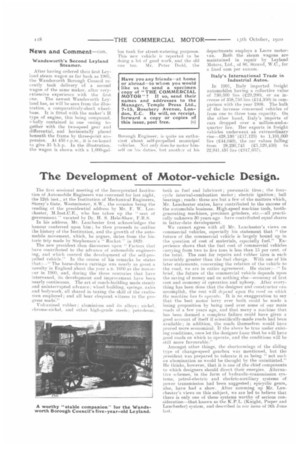The Development of Motor-vehicle Design.
Page 12

If you've noticed an error in this article please click here to report it so we can fix it.
The first sessional meeting of the Incorporated Institution of Automobile Engineers was convened for last night, the 12th inst., at the institution of Mechanical Engineers, Storey's (ate, Westminster, S.W., the occasion being the reading of the presidential address by Mr. F. W. Lanchester, M.Inst.C.E., who has taken up the " seat of government" vacated by Dr. H. S. Hele-Shaw, F.R.S. In his address, Mr. Lanchester first acknowledges the honour conferred upon him ; lie then proceeds to outline the history of the institution, and the growth of the automobile movement, which, he argues, dates from the historic trip made by Stephenson's " Rocket " in 1829.
The new president then discourses upon " Factors that have contributed to the advance of automobile engineering, and which control the development of the self-propelled vehicle." In the course of his remarks lie states that:—" The horse-drawn carriage was nearly as great fl novelty in England about the year A.D. 1600 as the motorcar in 1900, and, during the three centuries that have intervened, its development and improvement have been nearly continuous. The art of coach-building made steady and uninterrupted advance; wheel building. springs, axles and bodywork, all shared in taxing the skill of the craftsmen employed ; and all bear eloquent witness to the progress made."
Vulcanized rubber ; aluminium and its alloys ; nickel, chrome-nickel, and other high-grade steels; petroleum, both as fuel and labricant; pneumatic tires; the fourcycle internal-combustion motor; electric ignition ; ball bearings; roads: these are but a few of the matters which, Mr. Lanehester states, have contributed to the success of the automobile business. High-speed machine tools, toothgenerating machines, precision grinders, etc.—all practically unknown 30 years agohave contributed equal shares in latter-date development.
We cannot agree with all Mr. Lanchester's views on commercial vehicles, especially his statement that " the future of the commercial vehicle is largely bound up in the question of cost of materials, especially fuel," Experience shows that the fuel cost of commercial vehicles carrying from two to five tons is less than 15 per cent. of the total. The cost for repairs and rubber tires is each invariably greater than the fuel charge. With one of his later statements, concerning the relation of the vehicle to the road, we are in entire agreement. He states:--"In brief, the future of the commercial vehicle depends upon the saving of money and on nothing else—economy of first cost and economy of opration and upkeep. After everything has been done that the designer and constructor can accomplish, the rest will depend upon the rood on which the machine has to operate. It is no exaggeration to say that the best motor lorry ever built could be made a losing proposition by being used over some of our main roads of a few years ago, and that many a machine that has been deemed a complete failure could have given a good account of itself if scientifically-made roads had been available; in addition, the roads themselves would have proved more economical. If the above be true under existing conditions, once let the designer kn.ow that he will have good roads on which to operate, and the conditions will be still more favourable."
Amongst other things, the shortcomings of the sliding type of change-speed gearbox was mentioned, but the president was prepared to tolerate it as being " not such an abomination as would be thought by the uninitiated." He thinks, however, that it is one of the chief components to which designers should direct their energies. Alternative schemes, in the form of hydraulic-transmission systems., petrol-electric and electric-auxiliary systems of. power transmission had been suggested ; epicyclic gears, also, have had a show. After summing up Mr. Lanchester's views on this subject, we are lad to believe that there is only one of these systems worthy of serious consideration—that known as the K.P.L. (Knight, Pieper and Lanchester) system, and described iii our issue of 0th June lost.






















